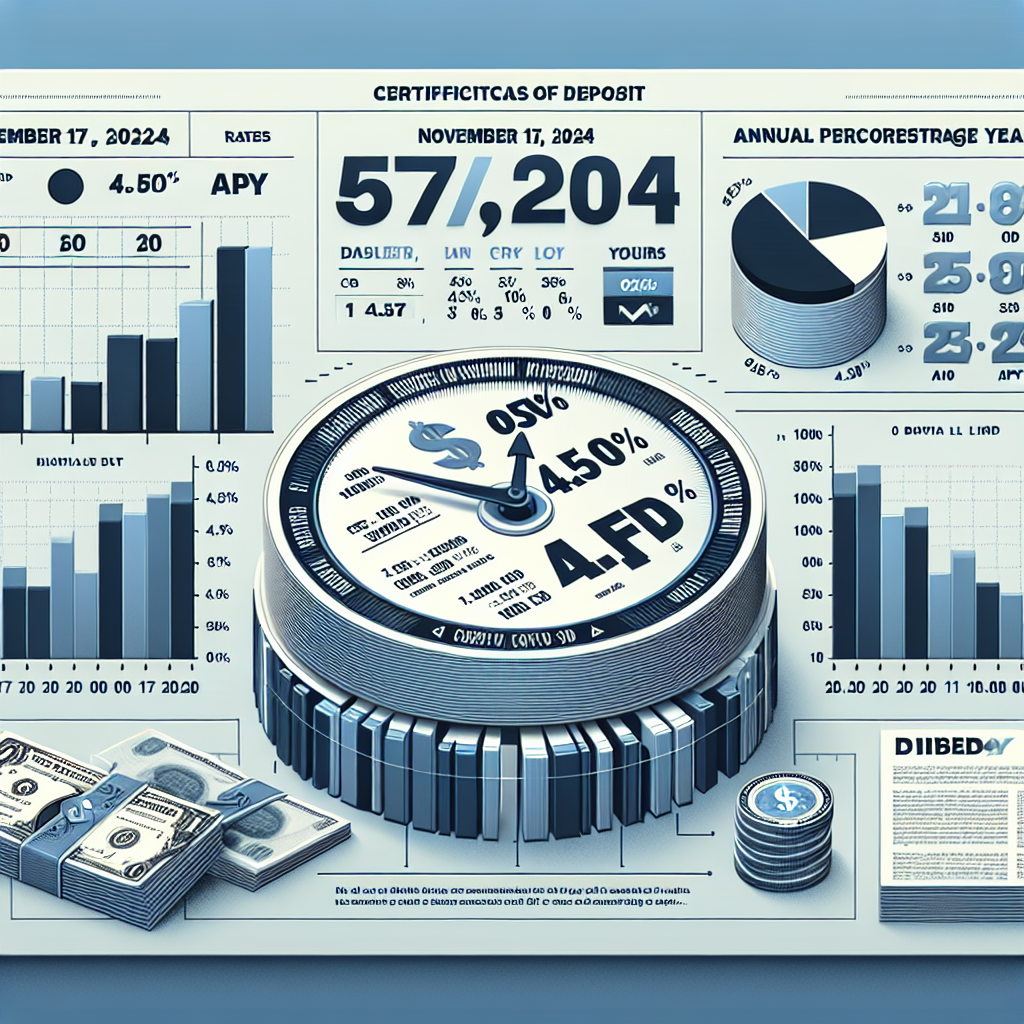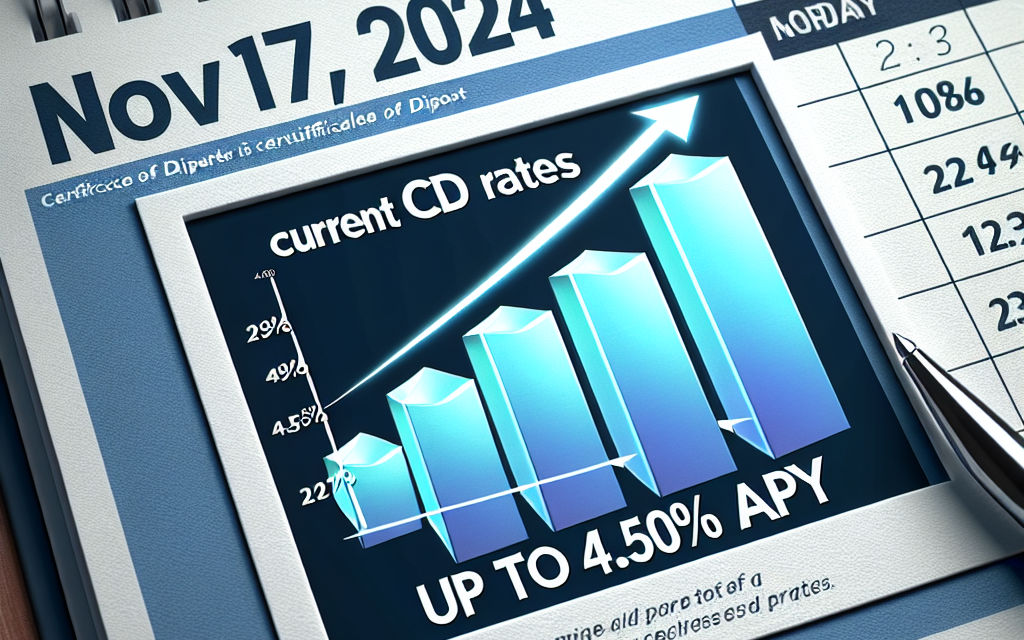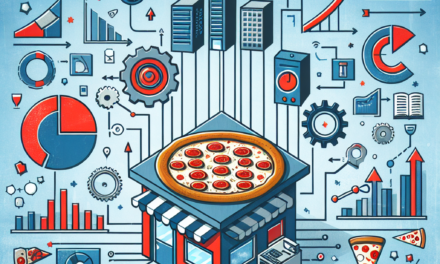“Secure Your Future: Lock in Up to 4.50% APY with November 2024 CD Rates!”
Introduction
As of November 17, 2024, the landscape of Certificate of Deposit (CD) rates presents a promising opportunity for savers and investors seeking stable returns. With interest rates experiencing fluctuations over the past year, financial institutions are now offering competitive CD rates, reaching up to 4.50% Annual Percentage Yield (APY). This marks a significant shift, providing individuals with a secure avenue to grow their savings over a fixed term. The current rates reflect broader economic trends and monetary policies, making it an opportune moment for those looking to lock in higher yields. As always, potential investors should carefully consider the terms and conditions associated with these financial products to ensure they align with their financial goals and timelines.
Understanding CD Rates: What Does 4.50% APY Mean for Your Savings?
As we navigate the financial landscape of November 2024, understanding the nuances of Certificate of Deposit (CD) rates becomes increasingly important for those looking to optimize their savings. With current CD rates reaching up to 4.50% Annual Percentage Yield (APY), it is crucial to comprehend what this figure means for your financial strategy. CDs, as a financial instrument, offer a fixed interest rate over a specified term, providing a secure and predictable return on investment. The APY, a key metric in evaluating CDs, represents the total amount of interest earned over a year, accounting for the effects of compounding. Thus, a 4.50% APY indicates a relatively attractive return in today’s economic climate, especially when compared to traditional savings accounts, which often offer lower rates.
To fully appreciate the implications of a 4.50% APY, one must consider the broader economic context. Interest rates are influenced by various factors, including central bank policies, inflation rates, and overall economic conditions. In recent years, fluctuating economic indicators have led to varying interest rate environments, making it essential for savers to stay informed about current trends. A 4.50% APY suggests a favorable environment for savers, as it provides an opportunity to earn a higher return on their deposits compared to other low-risk options. This rate can be particularly appealing for individuals seeking a balance between risk and reward, as CDs are generally considered a safe investment due to their fixed nature and FDIC insurance coverage.
Moreover, understanding the impact of compounding is vital when evaluating CD rates. Compounding refers to the process by which interest is added to the principal balance, allowing future interest calculations to be based on the increased total. This mechanism can significantly enhance the overall return on a CD, especially over longer terms. For instance, a CD with a 4.50% APY will yield more substantial returns if interest is compounded more frequently, such as monthly or quarterly, rather than annually. Therefore, when comparing CD options, it is important to consider not only the APY but also the compounding frequency to maximize potential earnings.
In addition to the attractive APY, CDs offer other benefits that can enhance their appeal as a savings vehicle. One such advantage is the predictability of returns, which can be particularly reassuring in uncertain economic times. Unlike stocks or mutual funds, which are subject to market volatility, CDs provide a guaranteed return, allowing savers to plan with confidence. Furthermore, the fixed term of a CD can instill a sense of discipline, as funds are typically locked in until maturity, reducing the temptation to dip into savings for impulsive purchases.
However, it is important to weigh these benefits against potential drawbacks. The primary limitation of CDs is their lack of liquidity, as early withdrawal often incurs penalties that can erode the interest earned. Therefore, it is crucial to assess one’s financial needs and ensure that funds allocated to a CD will not be required for immediate expenses. Additionally, while a 4.50% APY is competitive in the current market, it is essential to remain vigilant and periodically review available options to ensure that your savings strategy aligns with evolving financial goals.
In conclusion, a 4.50% APY on CDs presents a compelling opportunity for savers seeking a secure and predictable return on their investment. By understanding the factors influencing CD rates and the benefits of compounding, individuals can make informed decisions that enhance their financial well-being. As with any financial decision, careful consideration of one’s unique circumstances and objectives is paramount to maximizing the potential benefits of this savings instrument.
Comparing CD Rates: How November 2024 Stacks Up Against Previous Years
As we delve into the current landscape of Certificate of Deposit (CD) rates for November 17, 2024, it is essential to understand how these rates compare to those of previous years. With rates reaching up to 4.50% Annual Percentage Yield (APY), this period marks a significant point of interest for both seasoned investors and those new to the world of CDs. To appreciate the current rates, it is crucial to examine the economic factors that have influenced these changes over time.
Historically, CD rates have been subject to fluctuations driven by various economic conditions, including inflation, monetary policy, and overall market demand. In recent years, the global economy has experienced a series of challenges and recoveries, each leaving its mark on interest rates. For instance, the economic downturns of the early 2020s, exacerbated by the COVID-19 pandemic, led to historically low interest rates as central banks worldwide sought to stimulate economic activity. During this period, CD rates were notably lower, often hovering around 1% to 2% APY, making the current rates of up to 4.50% APY particularly noteworthy.
Transitioning from the low-rate environment of the early 2020s, the subsequent economic recovery brought about a gradual increase in interest rates. Central banks, including the Federal Reserve, began to adjust their monetary policies in response to rising inflation and a strengthening economy. This shift resulted in a steady climb in CD rates, reflecting the broader trend of increasing interest rates across various financial products. By 2023, CD rates had already begun to rise, with many financial institutions offering rates in the range of 3% to 4% APY.
As we compare the current rates to those of previous years, it becomes evident that the present rates are among the most attractive seen in recent memory. The increase to 4.50% APY can be attributed to several factors, including continued economic growth and persistent inflationary pressures. These conditions have prompted financial institutions to offer more competitive rates to attract depositors, thereby providing a more lucrative option for individuals seeking stable, low-risk investment opportunities.
Moreover, the current CD rates reflect a broader trend of increased competition among banks and credit unions. As financial institutions vie for consumer deposits, they are incentivized to offer higher rates to differentiate themselves in a crowded market. This competitive environment benefits consumers, who now have access to a wider array of options when selecting a CD that aligns with their financial goals.
In conclusion, the CD rates for November 17, 2024, represent a significant improvement over those of previous years, offering up to 4.50% APY. This increase is a testament to the evolving economic landscape and the strategic responses of financial institutions to changing market conditions. As investors consider their options, understanding the historical context and current economic factors influencing these rates is crucial. By doing so, they can make informed decisions that align with their financial objectives, taking advantage of the favorable conditions that the current CD market presents.
Maximizing Returns: Strategies for Investing in CDs with 4.50% APY
As we approach the end of 2024, the financial landscape continues to evolve, offering various opportunities for investors seeking stable returns. One such opportunity lies in Certificates of Deposit (CDs), which have become increasingly attractive due to rising interest rates. As of November 17, 2024, CD rates have reached up to 4.50% Annual Percentage Yield (APY), presenting a compelling option for those looking to maximize their returns while minimizing risk. Understanding how to strategically invest in CDs with these rates can significantly enhance one’s financial portfolio.
To begin with, it is essential to comprehend the nature of CDs and how they function. A CD is a time deposit offered by banks and credit unions, providing a fixed interest rate over a specified term. Unlike savings accounts, CDs require the investor to commit their funds for a predetermined period, ranging from a few months to several years. In return, they offer higher interest rates, making them an appealing choice for conservative investors. With the current rates reaching up to 4.50% APY, CDs are now more competitive compared to other low-risk investment vehicles.
One effective strategy for investing in CDs is laddering, which involves purchasing multiple CDs with varying maturity dates. This approach allows investors to benefit from higher rates on longer-term CDs while maintaining liquidity through shorter-term CDs. For instance, an investor might purchase CDs with terms of one, two, and three years. As each CD matures, the investor can reinvest the principal and interest into a new CD, potentially at a higher rate if interest rates continue to rise. This method not only maximizes returns but also mitigates the risk of being locked into a single rate for an extended period.
Another strategy to consider is aligning CD investments with financial goals. For those with short-term objectives, such as saving for a down payment on a house or a major purchase, short-term CDs can provide a secure way to grow funds without exposure to market volatility. Conversely, long-term CDs are suitable for investors with long-term goals, such as retirement savings, as they typically offer higher rates and compound interest over time. By matching CD terms with specific financial goals, investors can ensure that their funds are available when needed while still benefiting from attractive interest rates.
Furthermore, it is crucial to shop around and compare CD rates from different financial institutions. While the national average for CD rates may hover around a certain percentage, individual banks and credit unions often offer promotional rates that exceed the average. By conducting thorough research and comparing offers, investors can identify the best rates available, thereby maximizing their potential returns. Additionally, considering online banks, which often provide higher rates due to lower overhead costs, can be advantageous.
In conclusion, with CD rates reaching up to 4.50% APY as of November 17, 2024, investors have a valuable opportunity to enhance their portfolios through strategic CD investments. By employing strategies such as laddering, aligning investments with financial goals, and diligently comparing rates, investors can effectively maximize their returns while maintaining a low-risk profile. As the financial environment continues to shift, staying informed and adaptable will be key to making the most of these opportunities.
Economic Factors: What’s Driving CD Rates to 4.50% APY in November 2024?

As of November 17, 2024, certificate of deposit (CD) rates have reached a notable high, with some financial institutions offering up to 4.50% annual percentage yield (APY). This development marks a significant shift in the financial landscape, reflecting a confluence of economic factors that have influenced interest rates over recent months. Understanding these factors provides insight into the broader economic environment and the strategic decisions made by banks and credit unions.
To begin with, the Federal Reserve’s monetary policy plays a crucial role in shaping CD rates. Over the past year, the Federal Reserve has maintained a relatively tight monetary policy stance, primarily to combat inflationary pressures that have persisted in the economy. By raising the federal funds rate, the central bank aims to temper economic activity, thereby reducing inflation. This increase in the federal funds rate has a direct impact on the interest rates offered by financial institutions, including those for CDs. As banks face higher borrowing costs, they, in turn, offer higher rates to attract deposits, which explains the current elevated CD rates.
Moreover, the broader economic conditions have also contributed to the rise in CD rates. The labor market has shown signs of resilience, with unemployment rates remaining low and wage growth continuing to rise. This robust labor market has bolstered consumer confidence, leading to increased spending and investment. However, it has also added to inflationary pressures, prompting the Federal Reserve to maintain its rate hikes. Consequently, banks have adjusted their interest offerings to remain competitive and appealing to savers looking for secure investment options amidst economic uncertainty.
In addition to domestic factors, global economic dynamics have also influenced CD rates. The international economic environment has been characterized by volatility, with geopolitical tensions and supply chain disruptions affecting global trade and economic stability. These uncertainties have led investors to seek safer investment avenues, such as CDs, which are perceived as low-risk compared to equities and other volatile assets. As demand for these secure investment vehicles increases, financial institutions are incentivized to offer higher rates to capture a larger share of the market.
Furthermore, technological advancements and increased competition among financial institutions have played a role in driving CD rates upward. The rise of online banks and fintech companies has intensified competition in the banking sector, pushing traditional banks to offer more attractive rates to retain and attract customers. These digital platforms often have lower overhead costs, allowing them to pass on savings to consumers in the form of higher interest rates. As a result, traditional banks are compelled to adjust their rates to remain competitive in this evolving landscape.
In conclusion, the current CD rates of up to 4.50% APY as of November 17, 2024, are the result of a complex interplay of economic factors. The Federal Reserve’s monetary policy, domestic economic conditions, global uncertainties, and increased competition in the financial sector have all contributed to this trend. For savers, these elevated rates present an opportunity to earn higher returns on their deposits, while for financial institutions, they represent a strategic response to a dynamic and competitive market environment. As these factors continue to evolve, they will undoubtedly shape the trajectory of CD rates in the months to come.
CD Laddering: A Smart Approach to Take Advantage of Current Rates
As of November 17, 2024, certificate of deposit (CD) rates have reached a notable high, with some financial institutions offering up to 4.50% annual percentage yield (APY). This presents a compelling opportunity for savers looking to maximize their returns in a relatively low-risk environment. In this context, CD laddering emerges as a strategic approach to capitalize on these favorable rates while maintaining liquidity and flexibility in one’s investment portfolio.
CD laddering is a method that involves dividing an investment into multiple CDs with varying maturity dates. This strategy allows investors to benefit from higher interest rates on longer-term CDs while still having access to funds at regular intervals. For instance, an investor might choose to allocate their funds across CDs with maturities of one, two, three, four, and five years. As each CD matures, the investor can either reinvest the principal into a new five-year CD to continue the ladder or use the funds for other financial needs.
The primary advantage of CD laddering is that it mitigates the risk associated with interest rate fluctuations. In a rising rate environment, such as the current one, having CDs maturing at different times allows investors to reinvest at potentially higher rates. Conversely, if rates were to decline, the longer-term CDs in the ladder would continue to yield the higher rates locked in at the time of purchase. This balance between risk and reward makes CD laddering an attractive option for those seeking stability and growth in their savings.
Moreover, CD laddering provides a level of liquidity that is often absent in traditional CD investments. By staggering the maturity dates, investors have periodic access to a portion of their funds without incurring early withdrawal penalties. This can be particularly beneficial for individuals who may need to access their savings for unforeseen expenses or opportunities. The regular maturation of CDs ensures that a portion of the investment is always nearing liquidity, offering peace of mind and financial flexibility.
In addition to these benefits, CD laddering can be tailored to suit individual financial goals and timelines. Investors can adjust the number of rungs in the ladder, the amount allocated to each CD, and the maturity intervals to align with their specific needs. This customization allows for a personalized approach to savings that can accommodate both short-term objectives and long-term aspirations.
Furthermore, the current economic climate underscores the importance of a diversified investment strategy. While CDs are a secure option, they should be considered as part of a broader portfolio that includes other asset classes. This diversification helps to balance potential risks and rewards across different market conditions. By incorporating CD laddering into a comprehensive financial plan, investors can enhance their overall strategy and work towards achieving their financial goals with greater confidence.
In conclusion, the current CD rates of up to 4.50% APY present a unique opportunity for savers to enhance their returns. CD laddering offers a smart and effective way to take advantage of these rates while maintaining liquidity and flexibility. By understanding and implementing this strategy, investors can navigate the complexities of the financial landscape with greater ease and assurance, ultimately securing a more stable and prosperous financial future.
Risk vs. Reward: Are CDs with 4.50% APY the Right Choice for You?
As we navigate the financial landscape of November 2024, the allure of certificates of deposit (CDs) offering up to 4.50% annual percentage yield (APY) has captured the attention of many investors. This enticing rate prompts a critical evaluation of whether such CDs align with individual financial goals and risk tolerance. To make an informed decision, it is essential to weigh the potential rewards against the inherent risks associated with this investment vehicle.
Certificates of deposit are traditionally viewed as a safe investment option, primarily because they are insured by the Federal Deposit Insurance Corporation (FDIC) up to $250,000 per depositor, per insured bank. This insurance provides a safety net, ensuring that even in the unlikely event of a bank failure, the investor’s principal is protected. Consequently, CDs are often favored by risk-averse individuals seeking a stable and predictable return on their investment. However, the decision to invest in a CD with a 4.50% APY should not be made solely on the basis of its attractive yield.
One must consider the opportunity cost associated with locking funds into a CD. Unlike more liquid investments, such as stocks or mutual funds, CDs require the investor to commit their money for a predetermined period, ranging from a few months to several years. During this time, the investor cannot access their funds without incurring a penalty, which could negate the benefits of the higher interest rate. Therefore, it is crucial to assess one’s liquidity needs and ensure that the funds allocated to a CD will not be required for unforeseen expenses.
Moreover, the current economic environment plays a significant role in determining the suitability of a CD investment. With interest rates fluctuating in response to economic conditions, there is a possibility that rates could rise further in the near future. If this occurs, new CDs may offer even higher yields, potentially leaving those locked into a 4.50% APY CD at a disadvantage. Conversely, if interest rates were to decline, the fixed rate of a CD could prove advantageous, providing a stable return amidst a backdrop of falling yields.
Additionally, it is important to consider the impact of inflation on the real return of a CD investment. While a 4.50% APY may appear attractive, if inflation rates are high, the purchasing power of the returns could be eroded. Investors should compare the CD rate with the current inflation rate to determine the real rate of return, ensuring that their investment will indeed grow in value over time.
In conclusion, while CDs offering up to 4.50% APY present an appealing opportunity for those seeking a low-risk investment, it is imperative to conduct a thorough analysis of one’s financial situation and market conditions. By considering factors such as liquidity needs, interest rate trends, and inflation, investors can make a well-informed decision that aligns with their financial objectives. Ultimately, the choice to invest in a CD should be guided by a comprehensive understanding of both the potential rewards and the associated risks, ensuring that the investment serves as a prudent component of a diversified financial portfolio.
Future Projections: Will CD Rates Continue to Rise Beyond November 2024?
As we approach November 2024, the financial landscape is witnessing a notable shift, particularly in the realm of Certificate of Deposit (CD) rates. Currently, CD rates have reached up to 4.50% Annual Percentage Yield (APY), a figure that has captured the attention of both individual savers and financial analysts alike. This increase in rates prompts a critical question: will CD rates continue to rise beyond November 2024? To explore this, it is essential to consider the various economic factors and market dynamics that influence these rates.
Firstly, the broader economic environment plays a pivotal role in determining the trajectory of CD rates. The Federal Reserve’s monetary policy is a primary driver, as it directly impacts interest rates across the board. Over the past year, the Federal Reserve has adopted a more hawkish stance, gradually increasing the federal funds rate to combat inflationary pressures. This policy shift has contributed to the rise in CD rates, as financial institutions adjust their offerings to remain competitive and attract depositors. If the Federal Reserve continues on this path, it is plausible that CD rates could experience further upward momentum.
Moreover, inflation trends are another critical factor to consider. Persistent inflation can erode the purchasing power of savings, prompting savers to seek higher returns to preserve their wealth. In response, banks may offer more attractive CD rates to entice customers. However, if inflation begins to stabilize or decline, the pressure on financial institutions to raise CD rates may diminish. Therefore, monitoring inflationary trends will be crucial in predicting the future direction of CD rates.
In addition to monetary policy and inflation, the overall health of the banking sector is instrumental in shaping CD rates. A robust banking sector, characterized by strong balance sheets and healthy competition, is more likely to offer competitive rates. Conversely, if banks face financial challenges or increased regulatory pressures, they may be less inclined to raise CD rates. As of now, the banking sector remains relatively stable, but any shifts in this stability could influence future rate adjustments.
Furthermore, consumer behavior and market demand for CDs are significant considerations. As CD rates rise, they become more attractive to savers seeking low-risk investment options. This increased demand can lead banks to offer even higher rates to capture a larger share of the market. However, if alternative investment opportunities with comparable risk profiles and higher returns emerge, the demand for CDs may wane, potentially capping further rate increases.
Lastly, global economic conditions and geopolitical events can also impact CD rates. For instance, international trade tensions or economic slowdowns in major economies can create uncertainty, prompting investors to seek safe-haven assets like CDs. Such scenarios could lead to increased demand and potentially higher rates. Conversely, a stable global economic environment may exert less upward pressure on CD rates.
In conclusion, while current CD rates of up to 4.50% APY are enticing, predicting their future trajectory involves a complex interplay of factors. The Federal Reserve’s monetary policy, inflation trends, the health of the banking sector, consumer behavior, and global economic conditions all contribute to the potential for further rate increases. As we move beyond November 2024, these elements will continue to shape the landscape, offering both opportunities and challenges for savers and financial institutions alike.
Q&A
1. **What is the highest CD rate available as of November 17, 2024?**
The highest CD rate available is 4.50% APY.
2. **Which term length typically offers the highest CD rates?**
Longer-term CDs, such as 5-year CDs, typically offer the highest rates.
3. **Are there any promotional CD rates available?**
Yes, some banks and credit unions may offer promotional rates that exceed standard rates.
4. **What is the average CD rate for a 1-year term?**
The average CD rate for a 1-year term is around 3.00% APY.
5. **How do online banks’ CD rates compare to traditional banks?**
Online banks often offer higher CD rates compared to traditional banks due to lower overhead costs.
6. **What factors influence CD rates?**
CD rates are influenced by the Federal Reserve’s interest rate policies, economic conditions, and competition among banks.
7. **Are CD rates expected to rise or fall in the near future?**
CD rates are subject to change based on economic conditions and Federal Reserve policies, but specific future trends are uncertain.
Conclusion
As of November 17, 2024, current CD rates have reached up to 4.50% APY, reflecting a competitive environment for savers seeking to maximize returns on their deposits. This rate indicates a favorable interest rate climate, likely influenced by broader economic factors such as monetary policy adjustments and inflation trends. Savers should consider these rates as an opportunity to lock in higher returns, while also evaluating the terms and conditions associated with different financial institutions to ensure they align with their financial goals and liquidity needs.





